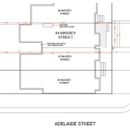Venting for multiple appliances
Hey GBA,
I wanted to reach out to the community for a thought experiment.
The home I am building will have the following :
High efficiency Gas furnace
High efficiency Gas water heater
ERV
Central vacuum
All of these require exterior intakes and exhausts.
The house is a row house, so the majority of the side walls are attached to another house. Thus, this only leaves one spot where I can place the multitude of vent pipes. (which is pretty much a small alcove at the rear between the two houses) see attached image.
With all those appliances above that means I’m going to have 3 independent intakes and 4 exhausts which mean a whole punch of piping through the basement and then termination outside all within inches of each other.
I am assuming you are not allowed to do a combined intake and exhaust. can someone please confirm or offer a suggestion. I’m trying to think of a way to make it more simple, pretty and avoid bulkheads or other interior and exterior design blunders.
Thanks,
Jamie
GBA Detail Library
A collection of one thousand construction details organized by climate and house part










Replies
Combining exhaust venting of power vented appliances would usually violate most manufacturers' installation requirements. There may be a way to combine air intakes for some appliances, but not others.
For the modest heating loads of a townhouse you may get better efficiency and more appropriate equipment sizing by using a condensing hot water heater and a small hydronic air handler, or if even micro-zone it on an individual room basis thin profile fan coils for heat distribution. That would get rid of one intake/exhaust vent pair. Run the room by room heating & cooling load calculations- this could be cheaper than a condensing gas furnace, and would improve the as-used net operating efficiency of the water heater by increasing it's duty-cycle.
In row houses it's tough to meet the minimum code & manufacturers' intake to exhaust spacing clearances to operable windows and ventilation intakes even without the alcove problem, which may be a serious issue for you in the narrow alcove you've indicated as the termination point. The minimum intake/exhaust separation for the ERV may also be tough to manage in that spot.
Venting the gas-burners through the roof with co-axial intake /exhaust vents may be possible.
Using a ductless HRV such as a Lunos may work, using vertical height to get the minimum separation between units.
Jamie,
Dana has given you some good suggestions.
In general, your choices include:
1. Consider substituting electric appliances for some or all of your gas-burning appliances.
2. Consider providing a vertical chase to the roof for some of the necessary penetrations.
The google street view of 44 Massey Street, Toronto, and the dimensions in the plot diagram provided in the initial post makes me think this house is amenable to being heated & cooled with a couple of 1-ton (or maybe 3/4 ton) ducted or ductless cold climate mini-splits, or a 1.5-2 ton multi-split, with the compressor(s) mounted in the alcove, above the historical snow depth line, or even on the roof, near the back edge of the fairly flat roofed section overlooking that alcove.
https://www.google.com/maps/@43.6434203,-79.4132816,3a,74.7y,259.13h,88.88t/data=!3m6!1e1!3m4!1sY-h3KpxnONLNx7QunvnTrw!2e0!7i13312!8i6656
It's the one with the bright red painted brick, with the big tree in the front yard, second gable in from Adelaide street, right?
The street view shows that there is already a flue on the front pitch of the main roof, so routing multiple 2-3" condensing exhaust stacks through the same chase shouldn't be very difficult, if that's the route you choose, which would mean taking the ventilation air at the alcove won't present an exhaust contamination issue. The intake(s) for the gas burning equipment could also come via the alcove.
The drone-view of the back side shows the flat roof & alcove, but the low resolution & distortion of the rendering doesn't yield very much fine detail.
https://www.google.com/maps/@43.6431618,-79.4141154,59a,35y,90h,45.04t/data=!3m1!1e3